Bio98 Lecture 13 PDH and TCA Intro
1/24
There's no tags or description
Looks like no tags are added yet.
Name | Mastery | Learn | Test | Matching | Spaced |
|---|
No study sessions yet.
25 Terms
Cyclic nucleotide second messengers
Adenylate cyclase & Guanylate cyclase
-classical signaling molecules
-produced from ATP & GTP (purines)
-made by just about every organism
-second messengers amplify initial signals

Linking signaling and metabolism
1) Low glucagon = increased glucagon, adenylate cyclase, and cAMP → activates protein kinase A
2) Activated protein kinase A = Phosphorylation of:
-Pyruvate kinase: gets inactivated
-PFK2 (dual function enzyme): gets inactivated, activates phosphatase → decrease in F-2,6-bP levels
3) Glycolysis rate decreases!
Know the cellular compartment metabolic processes occur in
1) Glycolysis happens in the cytosol
2) Pyruvate is shuttled into the mitochondria
3) TCA cycle and electron transport chain happen in the mitochondria
Electron transport chain requires oxygen to work – hence, aerobic metabolism; other compounds can feed into TCA cycle besides glucose
How can degrading amino acids & fatty acids result in the production of acetyl CoA?
pyruvate dehydrogenase complex can be bypassed as a result of the breakdown of fatty acids and amino acids.
Know PDH and what it is doing
PDH = Pyruvate dehydrogenase enzyme
-requires a lot of cofactors
-end result: NADH, CO2, and acetyl CoA
Pryuvate undergoes oxidative decarboxylation to make acetyl-CoA: oxidation through NAD → NADH, decarboxylation bc we’re removing the carboxylic acid group & causes release of CO2
2)
Remember the 3 cofactors used by PDH and their respective subunits
3 cofactors: TPP, lipoate, FAD
3 subunits: E1, E2, E3.
What’s Coenzyme A?
-has an adenine, a ribose, and a diphosphate with another phosphate hanging off the bottom.
-nucleotide-based cofactor, or coenzyme
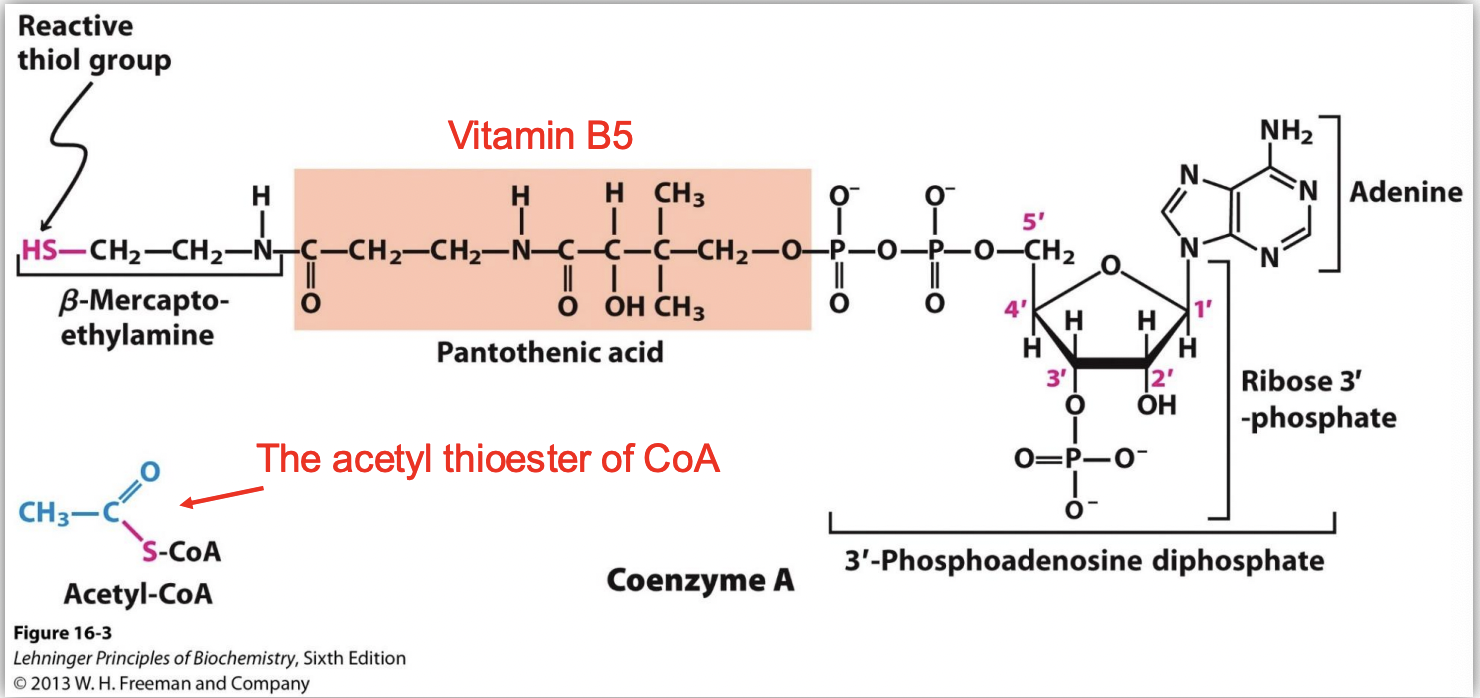
-also has pantothenic acid (product of vitamin B5 metabolism)
-coenzyme A gets acetylated into acetyl-CoA.
Subunit of PDH: E1
takes pyruvate and pops off the CO2 → acetylates (or adds) the rest of the pyruvate molecule onto TPP (cofactor)
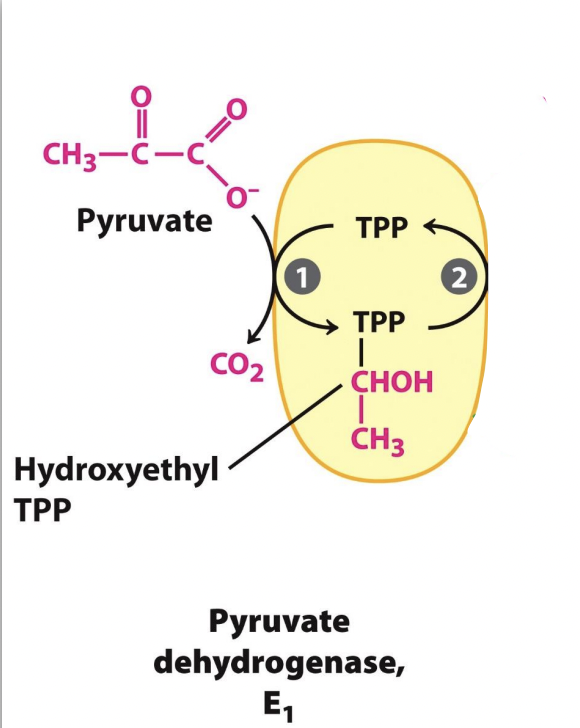
Subunit of PDH: E2
lipoate or acyl lipolycine passes (or transitions) the TPP pyruvate complex off to CoA to generate acetyl CoA.
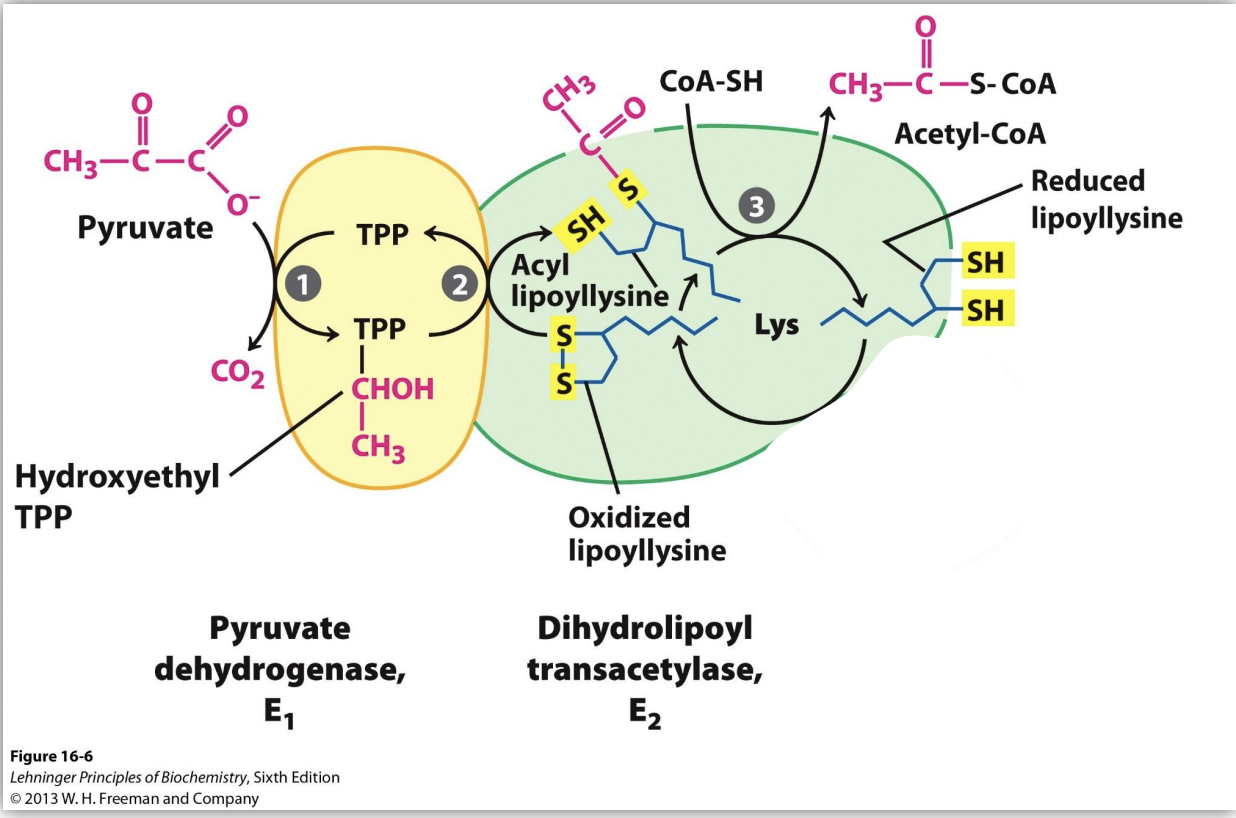
Subunit of PDH: E3
-regenerates all the cofactors
-binds FAD and generates FADH2
-takes NAD+ and regenerates NADH
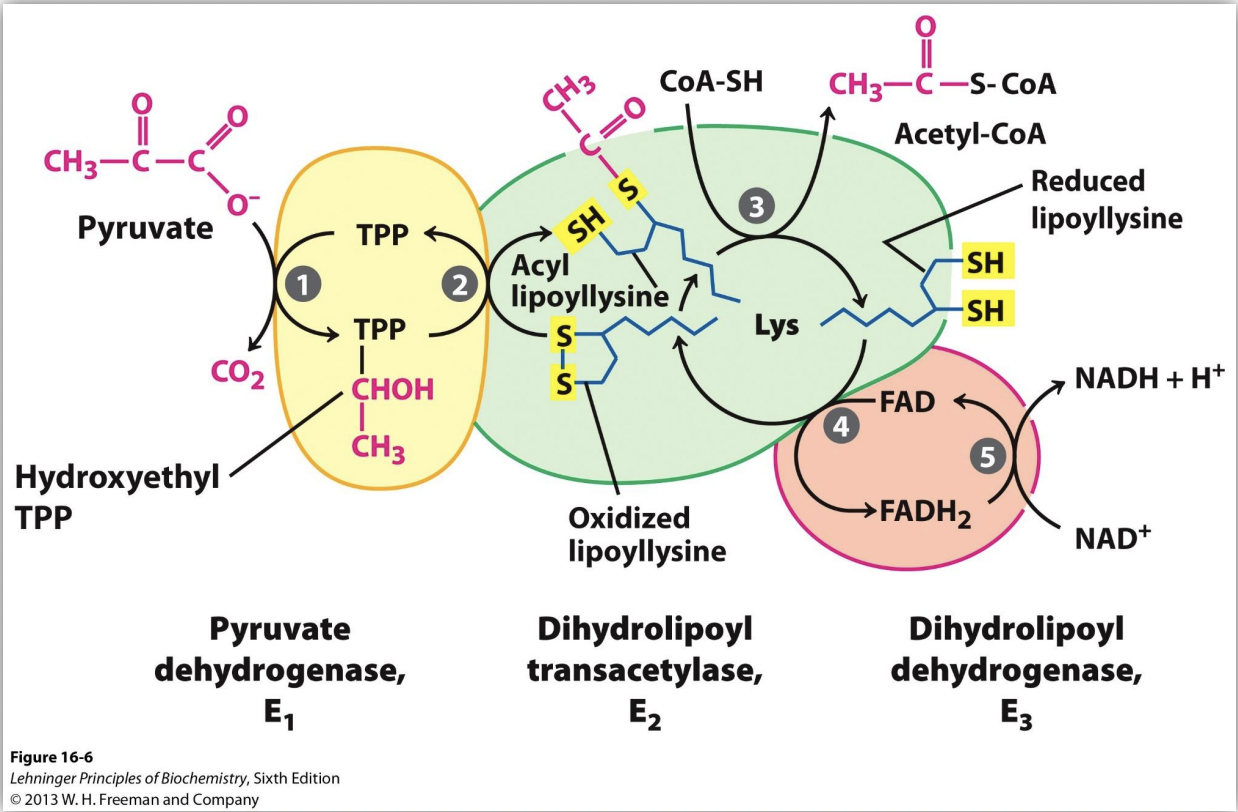
PDH 3D Organization
An Icosahedron complex = 24 E1 + 24 E2 + 12 E3
-E1, E2 and E3: each has its own prosthetic group
-E1 (binds to): TPP, E2: lipoic acid, E3: FAD
Pyruvate decarboxylase vs Pyruvate dehydrogenase
-Pyruvate decarboxylase -> alcohol (yeast only)
-Pyruvate dehydrogenase -> acetyl-CoA -> feeds into TCA cycle
-Both these enzymes are catalyzing the same type of rxn at decarboxylation (the release of CO2 and production of acetyl-CoA)
Pyruvate dehydrogenase: 1) Decarboxylation
-Decarboxylate pyruvate
-takes TPP as a co-factor, which has a negative and positive formal charge.
-takes pyruvate and TPP (E1), and through 2 protons exchange, we get this hydroxyethyl TPP adduct that’s formed & the release of the carboxylic acid is CO2.
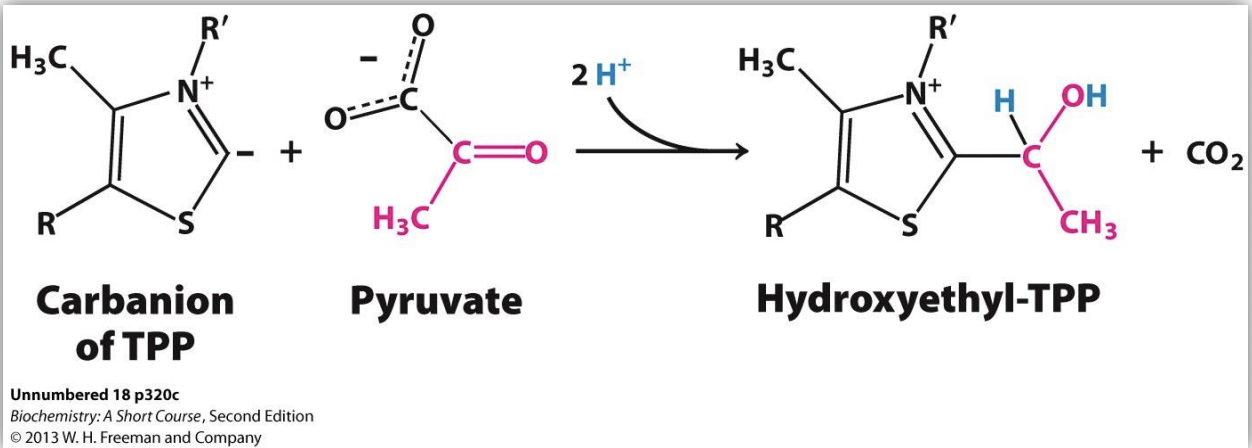
Pyruvate dehydrogenase: 2) Oxidation
-Lipoic acid/lipoate (E2): used as an antioxidant; found in cells with lots of mitochondria (ex. red meat, spinach)
-lipoate is fused toto a lysine residue; lipoate has a disulfide that gets reduced and breaks, which will give the acetylated form of lipoic acid.
-hydroxyethyl TPP from step 1 (E1) recombines with lipoamide (oxidized form of lipoic acid) = acetylated form of lipoic acid, regenerated positive and negative ILLID for TPP
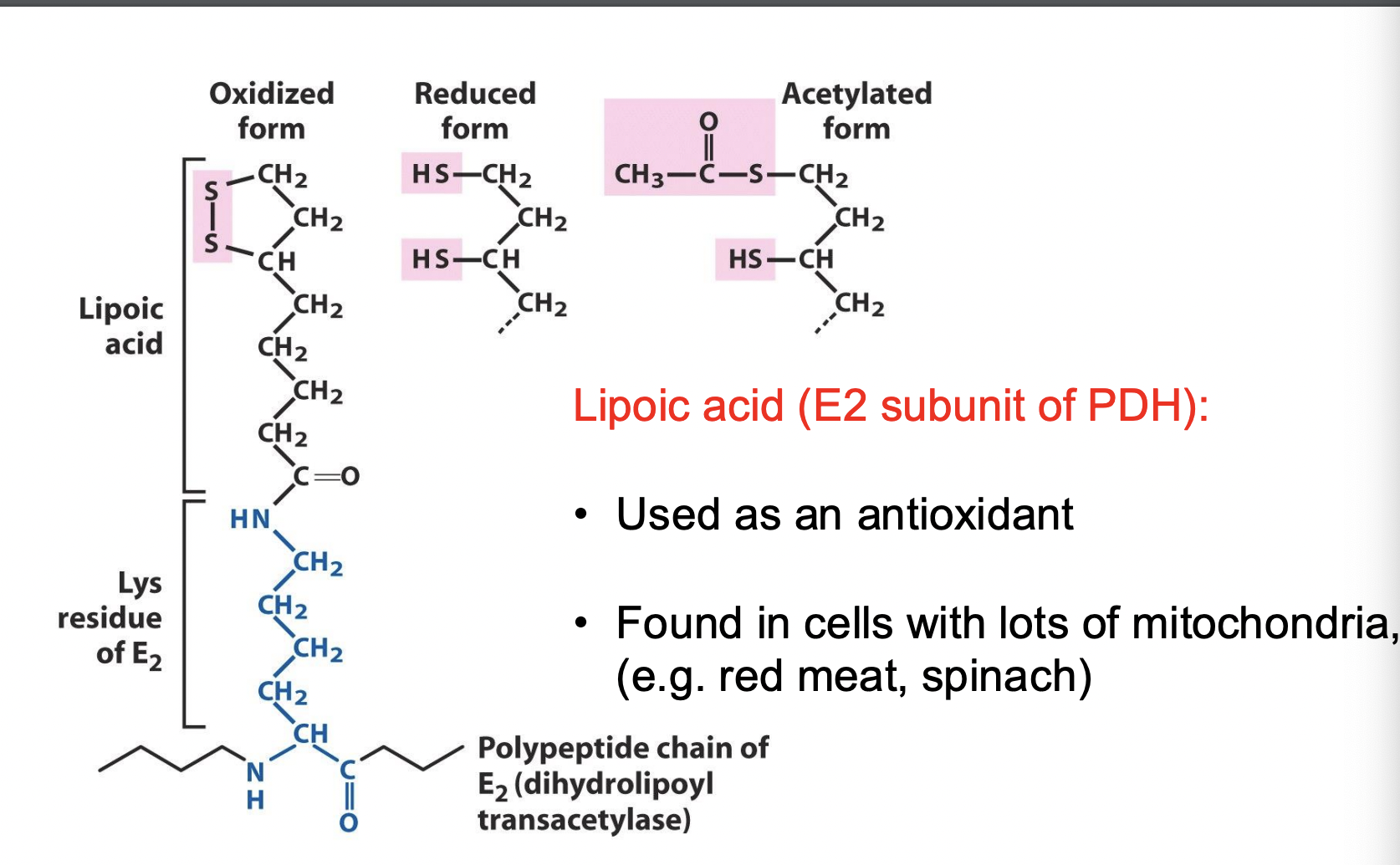
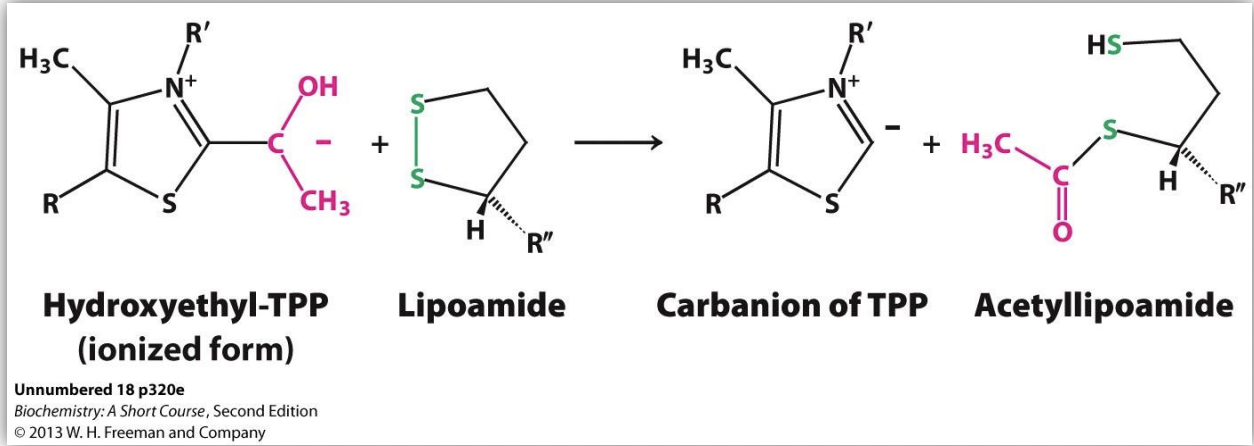
Pyruvate dehydrogenase: 3) Transfer (dihydrolipoyl transacetylase)
-acetylated lipoamide interacts with coenzyme A
-CoA and acetylated lipoamide interact to make acetyl CoA & dihydrolipoamide (reduced form of lipoic acid)

-E3 comes in using FAD (vitamin B2) as a cofactor
(E2 to E3 handoff)
Pyruvate dehydrogenase: 4) Regeneration (dihydrolipoyl dehydrogenase)
-dihydrolipoamide (reduced form of lipoic acid) interacts with FAD to regenerate lipoamide
-NAD also gets involved to regenerate NADH
-Summary: E3 regenerates oxidizied lipoic acid (lipoamide) and generates NADH

Large complex allows ___
efficient substrate shuttling.
-lipoic acid helps transport the intermediates
TCA names
-Tricarboxylic acid cycle
-Krebs cycle
-citric acid cycle
-uses acetyl-CoA and water to product NADH and CO2 (for every acetyl-CoA entering the cycle→ 3 NADH produced)
Understand the concept of metabolic tracing
-use isotope tracing
-depending on the number of labels on the starting material, you might have differing number of labels on average in the final products.
Radioatracing
-Radioisotopes
-Radioactivity is much more sensitive (you need less incorporation to see it)
-Requires lots of extra certification to use in the lab
-Can’t determine different labeled molecules form each other w/o separation
Stable isotope
-non-radioactive (no safety concerns)
-can be readily separated by chromatography and visualized by mass spectrometry
-requires significantly more incorporation
5 Vitamins & their biological roles
• B1 (thiamine) ➔ TPP (PDH E1)
• Lipoic acid (PDH E2)
• B2 (riboflavin) ➔ FAD (PDH E3)
• B3 (niacin) ➔ NAD
• B5 (pantothenic acid) ➔ Coenzyme A
• Deficiency causes mild depression, moodiness, fatigue, mouth sore, headache
What are the prosthetic groups of pyruvate dehydrogenase?
E1-TPP, E2-lipoic acid, E3-FAD
What are the products of pyruvate dehydrogenase?
E1-CO2, E2- acetyl-CoA and E3-NADH
PDH Total
1xNADH per pyruvate (2x per glucose)